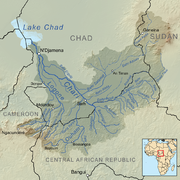Sara people
Central Sudanic peoples |
The Sara people are a
Sara oral histories add further details about the people. In summary, the Sara are mostly animists (veneration of nature), with a social order made up of several patrilineal clans formerly united into a single polity with a national language, national identity, and national religion. Many Sara people have retained their ethnic religion, but some have converted to Christianity and Islam.[7]
Overview

In Chad
The Sara (Kameeni) are the largest ethnic group in the Republic of Chad, they're concentrated in the

The local Muslim groups of what is now Chad, referred to the Sara as "Kirdi", with the term "Kirdi" denoting a non-Muslim person. The Muslim raiders of what is now Chad were autonomously called "Bagirmi", and this geo-political conflict between the Kirdi and the Bagirmi continued through the nineteenth century.[11][12]
The French colonial empire entered the ongoing hostilities in the early twentieth century, and the Sara people became a part of the French Equatorial Africa, more specifically as part of the "le Tchad utile". The Sara society was transformed by this development, both in terms of culture such as French-based education and training, but also socio-economically because of forced labor and conscription to serve the French military during the World Wars.[11] At the time of independence from France in 1960, the southerners of Chad were more assimilated into French institutions than the northerners.[11] This led to their political dominance of the country after 1960. They were also a part of the civil war with populations in north and central Chad, each population aligning with a different ideology.[12]
In the Central African Republic
The Sara people make up ten percent of the population of the Central African Republic, making it the fourth largest ethnic group in the country. They live in the northwest part of CAR.[citation needed]
Languages
The Sara people natively speak the Sara languages. This dialect cluster belongs to the Nilo-Saharan family.[citation needed]
Religion
The Sara people are mainly Christian and animist, with a minority of Muslims.[citation needed]
Genetics
Analysis of classic genetic markers and DNA polymorphisms by Excoffier et al. (1987) found that the Sara are most closely related to the
Notable Sara people
- Sosthene Moguenara, Chadian-born German track and field athlete
- Action for Unity and Socialism
- 1975 coup
- Kalthouma Nguembang, only woman in Chadian National Assembly in 1968
- President of Chad
- Japhet N'Doram
- Ange-Félix Patassé, President of Central African Republic from 1993 to 2003
- Martin Ziguélé, Former Prime Minister of Central African Republic[14]
See also
References
- ^ "Chad". Retrieved 3 April 2019.
- ^ "Central African Republic". Retrieved 3 April 2019.
- ^ Sara people, Encyclopædia Britannica
- ^ Sara languages, Ethnologue
- ^ Chad: Society and People, CIA Factbook, US Government
- ISBN 978-1-57505-956-3.
- ^ ISBN 978-0-313-27918-8.
- ISBN 978-1-135-30080-7.
- ISBN 978-1-135-45670-2.
- ^ Mario Zamora et al (1981), Image and Reality in African Interethnic Relations: The Fulbe and their Neighbors, US Department of Education, pages 136-137, 162-167
- ^ ISBN 978-0816118403.
- ^ ISBN 978-0-19-533770-9.
- . Retrieved 1 September 2016.
- ^ ETH Zurich (2021). EPR Atlas: Central African Republic (PDF) (Report). p. 341. Retrieved 25 July 2023.
Bibliography
- Cahiers d'Études africaines, Vol. 20, Cahier 80 (1980)
- René Lemarchand, Chad: The Misadventures of the North-South Dialectic, in: African Studies Review, Vol. 29, No. 3 (Sept., 1986)
- Mario Azevedo, The Human Price of Development: The Brazzaville Railroad and the Sara of Chad, in: African Studies Review, Vol. 24, No. 1 (Mar., 1981)
- Mario Azevedo, Power and Slavery in Central Africa: Chad (1890-1925), in: The Journal of Negro History, Vol. 67, No. 3 (Autumn, 1982)
- Robert Jaulin, La Mort Sara, Paris, 10/18, 1971 (1967)
